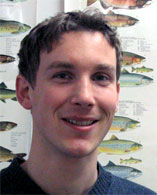 UNIVERSITY AND PROFESSIONAL QUALIFICATIONS
 2007 2007 |
Post-doctorat |
| |
Université Laval, Québec, Canada |
| |
|
 2002 2002 |
Ph.D., Université Pierre et Marie Curie (Paris VI), France |
|
|
 1999 1999 |
MSc., Université de Paris Sud, France |
| |
|
|
| |
 RESEARCH FIELDS
 |
Molecular evolution |
|
|
 |
Phylogeny |
| |
|
 |
Population genetics |
| |
|
 |
Functional genomics |
| |
|
 |
Bioinformatics tools |
|
| |
 RESEARCH PROGRAM
The long-term objective of my research program is to predict and explain functional interactions between host and its associated microbial communities (host-microbiota interactions) and responses to selective pressures exerted by natural environmental changes.
Microbiota are substantially involved in a wide range of host functions, including immune defense, metabolism, and reproduction. This close interaction has been suggested to result from a highly coevolved symbiosis and commensalisms influenced by nutrition, physiology and immunological factors. Until recently, the endogenous microbiota of metazoan organisms has been inaccessible to taxonomic census in any reasonable detail. For example, in vitro cultivation, the stalwart of microbiology for the last 200 years frequently failed to detect even the most abundant members of microbial communities. The health implications of the interaction between a host and its associated microbial species are now apparent. In the perspective of conservation and durable exploitation of aquatic species, it is thus crucial to also understand the implications of host-microbiota functional interactions and the influence of the environmental microbial communities in fish populations. With the advent of next generation DNA sequencing technologies, it is now possible to generate datasets of unprecedented size to simultaneously evaluate both the compositional and functional properties of microbial communities. Such technological developments shine a light on the intimate functional relationships between host and their endogenous microbial communities. Our expertise on bacterial community profiling (taxonomy and functions) was applied to quantify the influence of both genetic (host QTLs) and environmental factors (surrounding water, physiological stress) that are at play to modulate the properties of host microbiota in salmonids. Our research team pioneered the development of endogenous probiotics for salmonid aquaculture, specifically selected to counteract opportunistic pathogens. In vivo trial on brook charr (Salvelinus fontinalis) revealed a decrease in mortality up to 85% in tanks treated with our probiotics. By monitoring the whole communities, we are also able to accurately identify where the probiotic counteracts the targeted pathogen, and to assess the innocuity of our probiotic strains on the microbiota homeostasis. Our research team is actually working in partnership with Lallemand Inc., an industrial company specialized in animal and human nutrition.
Past and ongoing projects:
- Recent environmental perturbation impacts on the dynamic and structure of microbial community taxonomic diversity. NSERC Discovery. The goal of this project was to characterize qualitatively and quantitatively the different bacterial species (ribotypes) belonging to the perturbed and reference microbial communities, in order to test whether perturbed microbial communities exhibit less taxonomic groups, and are more homogeneous in terms of species, when compared to reference communities.
- Functional characterization of microbial communities exposed to recent environmental perturbations. NSERC Discovery. The goal of this project is to characterize functional properties of microbial communities exposed to a recent environmental perturbation, in order to identify candidate genes involved in the community adaptation, and to test to which extent a strong selective pressure is able to shift the functional properties of a bacterial community.
- Genetic and physiological bases of performances for growth rate, reproduction, and opportunistic disease resistance in brook char (Salvelinus fontinalis). NSERC SPS, Coll. L. Bernatchez (IBIS) and Céline Audet (UQAR). The goal of this project is to optimize genetic marker assisted selection (MAS) for traits of economical interest, and to develop sustainable alternatives for disease control by (i) selecting traits associated to growth rate, delayed sexual maturation, and opportunistic disease resistance, and (ii) gaining an accurate knowledge of the interspecific interactions in the microbial community involved, in order to develop brook char specific probiotics.
- FishProbio: Efficient and sustaining alternative strategy to prevent and treat a major opportunistic infection in salmonids, the cold disease. NSERC SEP, Coll. M. Castex (Lallemand Inc.). The goal of this project is to compare the efficiency of a commercial probiotic strain from Lallemand (Bactocell®) with our best endogenous probiotic strain.
- FishProbio: Efficient and sustaining alternative strategy to prevent and treat two major opportunistic diseases in salmonids, columnaris and furonculosis. SORDAC-MAPAQ, Coll. S. Charette (IBIS). The goal of this project is to test in vivo the efficiency of endogenous probiotic strains that exhibited in vitro antagonism effects for columnaris and furonculosis causative agents.
- Development of a diagnostic kit for highly virulent furonculosis causative agent strain from Québec. SORDAC-MAPAQ, PI: S. Charette (IBIS), coll. N. Derome. The goal of this project is to sequence the whole genome of highly virulent Aeromonas salmonicida strains present in aquaculture industry in Québec in order to develop accurate PCR diagnostic markers.
- Identication of SNP genetic marker associated to hygienic behavior toward developing GEBV in honey bees (Apis mellifera). PSIA-MAPAQ, Coll. P. Giovenazzo (CRSAD). The goal is to identify both coding and non-coding genes associated to a trait linked to disease resistance: the hygienic behavior. The candidate markers will allow to develop a Genomic Estimator of Breeding Value (GEBV) for honey bees.
- Biomonitoring tool of viral infection prevalence in honey bee colonies (Apis mellifera) under agro environmental context. PCAA-CDAQ, Coll. M. Chagnon (UdM). The goal of this project is to provide a biomonitoring tool assessing environmental quality, based on the impact exerted by sub-lethal doses of a neonicotinoid pesticide (thiametoxam) on honey bee performance traits.
- Genomic characterization of pathogens associated to the honey-bee (Apis mellifera) and to its own mite parasite (Varroa destructor) in Quebec. PSIA-MAPAQ, Coll. P. Giovenazzo (CRSAD). The aim was to test to what extent varroa mites are responsible in virus propagation in apiaries. Specific objectives were: (i) to characterize viral pathogens that are present on honey-bees and varroa mites, and describe the temporal evolution of these viruses using real-time PCR in two set of colonies: with and without a treatment against varroa mites, (ii) to conduct an epidemiologic study of the main pathogen found in the most important apiaries in Quebec.
|
| |
 ONGOING RESEARCH
- Infections caused by opportunistic pathogens in brook charr (Salvelinus fontinalis) aquaculture: impact on the microbial community.
- Dissection the genetic architecture of response to a breeding selection program in brook charr (Salvelinus fontinalis).
Collaborators: Dr Louis Bernatchez, Université Laval, and Dr Céline Audet, UQAR.
- Dissection the genetic architecture of reproductive isolation and adaptive phenotypic variation between sympatric forms of the lake whitefish (Coregonus clupeaformis Salmonidae) by combining a linkage map and the analysis of transcription profiles of genes.
Collaborators: Dr Louis Bernatchez, Université Laval and Dr Sean Rogers, University of Calgary.
- Genetic bases of post-zygotic isolation in Drosophila simulans complex, a functional genomic approach.
Collaborator : Dr Catherine Montchamp-Moreau, CNRS, Gif/Yvette, France.
|
| |
 LAB MEMBERS
 Martin Llewellyn Post-doctoral fellow. Martin Llewellyn Post-doctoral fellow.
 Mohamed Alburaki Post-doctoral fellow. Mohamed Alburaki Post-doctoral fellow.
 Sébastien Boutin Ph.D. Sébastien Boutin Ph.D.
 Malo Le Boulch Ph.D. Malo Le Boulch Ph.D.
|
 PUBLICATIONS
|
| Derome, N., Baudry, E. Ogereau, D. Veuille, M. and C. Montchamp-Moreau. Large-scale non-adaptive selective sweep caused by synergy between two linked segregation distorter in Drosophila simulans. Mol Biol Evol, accepté 04/09/2007. |
 |
| Derome, N. and L. Bernatchez. The transcriptomics of ecological convergence between two limnetic coregonine fishes (Salmonidae). 2006. Mol Biol Evol, 23: 1-9. |
 |
| Baudry*, E., Derome*, N., Huet, M. and M. Veuille. Worldwide variation patterns in Drosophila simulans show unexpected differences between African populations. 2006. Genetics, 173: 759-67. *: co-premiers auteurs. |
 |
| Derome, N., Duchesne, P. and L. Bernatchez. Parallelism in gene transcription among sympatric lake whitefish (Coregonus clupeaformis Mitchill) ecotypes. 2006 Mol Ecol, 15: 1239-49. |
 |
| Derome, N., Metayer, K., Montchamp-Moreau, C. and M. Veuille. Signature of selective sweep associated with the evolution of sex-ratio drive in Drosophila simulans. 2004 Genetics, 166: 1357-66. |
 |
| Derome, N., Chen, W.J., Dettai, A., Bonillo, C., and G. Lecointre. Phylogeny of antarctic dragon fishes (Bathydraconidae, Notothenioidei,Teleostei) and related families based on their anatomy and two mitochondrial genes. 2002. Mol Phyl Evol, 24: 139-52. |
 |
| Mousset, S., Derome, N. and M. Veuille. A test of neutrality and constant population size based on the mismatch distribution. 2004. Mol Biol Evol, 21: 724-731. 6. |
 |
| Mousset, S. and N. Derome. Molecular polymorphism in Drosophila melanogaster and Drosophila. simulans: What did we learn from recent studies ? 2004. Genetica, 120: 79-86. |
 |
| Jutier, D., Derome, N. and C. Montchamp-Moreau. Sex-ratio drive in Drosophila simulans. 2004. Genetica, 120: 87-99. |
 |
| Atlan, A., Capillon, C., Derome N. Couvet D. and C. Montchamp-Moreau. The evolution of autosomal suppressors of sex-ratio drive in Drosophila simulans. 2003. Genetica, 117: 47-58. |
 |
| Veuille M., Baudry E., Cobb M., Derome N. and E. Gravot. Historicity and the population genetics of Drosophila melanogaster and D. simulans. 2004. Genetica, 120: 61-70. |
 |
| Pisano, E., Mazzei, F. Derome, N., Ozouf-Costaz, C., Hureau, J. C. and G. Di Prisco. Cytogenetics of the bathydraconid fish Gymnodraco acuticeps (Perciformes, Notothenioidei) from Terra Nova Bay, Ross Sea. 2001. Polar Biol, 24: 846-852. |
 |
| |
 |
 SUBMITTED ARTICLES
|
| 15. Derome, N. Bougas, B., Rogers S., Whiteley A. Labbe, A. Laroche, J. & L. Bernatchez. Pervasive sex-linked effects on transcription regulation as revealed by eQTL mapping in lake whitefish species pairs (Coregonus sp, Salmonidae). Soumis à Genetics. |
| 14. Saint-Cyr, J. Derome, N. & L. Bernatchez. The transcriptomics of life-history trade-offs between whitefish species pairs (Coregonus sp.). Soumis à Molecular Ecology. |
| |





